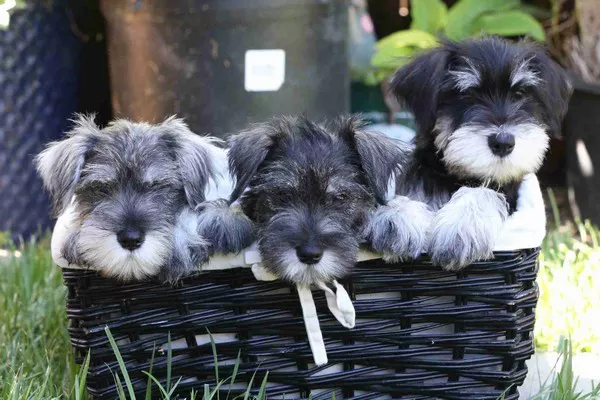Standard Schnauzers, with their distinctive appearance and vibrant personalities, are a popular choice among dog enthusiasts. One of the intriguing aspects of this breed is the variety of colors they come in. In this article, we’ll take a closer look at the different colors of standard schnauzers, offering insights into the unique shades that adorn these charming dogs.
1. Salt and Pepper:
The most recognizable and iconic coloration of the standard schnauzer is the “salt and pepper” coat. This coat features a combination of dark and light hairs, creating a salt-and-pepper appearance. The dark hairs are usually black, while the light hairs can range from shades of silver to white. This color variation gives the breed its classic and distinguished look.
2. Black:
While salt and pepper is the predominant color, some standard schnauzers come in solid black coats. The black coat is sleek and glossy, showcasing the breed’s elegance. It’s worth noting that while black is a distinct color, the salt-and-pepper gene can sometimes cause black-coated schnauzers to have a slightly faded appearance.
3. Black and Silver:
Another captivating color variation is the black and silver coat. In this coloration, the dog’s body is primarily black, while the eyebrows, whiskers, and legs exhibit a silver hue. This creates a striking contrast and adds a touch of uniqueness to the schnauzer’s appearance.
4. Bicolor:
Bicolor schnauzers display a combination of two distinct colors. Common combinations include black and white or black and cream. The second color typically appears on the dog’s chest, legs, and possibly parts of the face. Bicolor schnauzers showcase a playful and eye-catching contrast.
5. Other Variations:
While the standard schnauzer breed is most commonly seen in the aforementioned colorations, there can be occasional variations or combinations of these colors. It’s essential to note that while the coat colors may differ, the breed’s temperament, characteristics, and overall appeal remain consistent across all variations.
6. Grooming and Coat Maintenance:
Regardless of the color variation, maintaining a standard schnauzer’s coat requires regular grooming to ensure its health and appearance. Brushing, clipping, and occasional baths help keep the coat clean and free of tangles. Proper grooming enhances the coat’s natural shine and ensures the dog’s overall well-being.
Conclusion
In conclusion, the colors of standard schnauzers showcase the breed’s diversity and individuality. From the classic salt and pepper coat to the sleek black and silver variation, each color adds a layer of charm to these delightful dogs. Whether you’re drawn to the traditional or the more unique colorations, standard schnauzers are sure to capture your heart with their charismatic presence.
Fun Facts About Standard Schnauzer Coat Colors
1. Salt and Pepper’s Hidden Rainbow:
Did you know that the salt and pepper coat of standard schnauzers can actually vary quite a bit? The “pepper” portion can range from deep charcoal to lighter shades of gray, creating a subtle rainbow of colors within this classic coat variation.
2. Black and Silver Elegance:
The black and silver coat variation often gives standard schnauzers a dapper and sophisticated appearance. Interestingly, the silver coloration often becomes more prominent with age, leading to an even more distinguished look as these dogs grow older.
3. Bicolor Quirkiness:
Bicolor schnauzers are like a canvas where creativity meets canine charm. The contrast between the two colors can result in unique and unexpected patterns. From a “tuxedo” effect to adorable “socks” on their paws, these variations highlight the individuality of each dog.
4. Camouflage Effect:
In the world of standard schnauzers, the salt and pepper coat isn’t just about aesthetics; it’s also practical. This coat’s mix of dark and light hairs can create a camouflage effect, helping these dogs blend into their surroundings, which might have been a helpful trait in their historical roles as versatile working dogs.
5. “Blending In” with Beard and Eyebrows:
One of the signature features of schnauzers is their distinctive bushy eyebrows and beard. These features, along with their salt and pepper coat, can give them a unique ability to blend in with various environments – a natural talent for a breed with a history of being watchdogs and companions.
6. Mythical Ties:
In German folklore, schnauzers are said to have a connection to mythical creatures known as “Rattenfängers” or rat catchers. The idea was that schnauzers’ coats, often gray and brown, allowed them to blend into their surroundings while they fulfilled their role of catching rats and other vermin.
7. Color Psychology:
Different coat colors can sometimes be associated with certain psychological traits. For instance, black-coated schnauzers might be perceived as more mysterious and elegant, while salt and pepper variations can convey a sense of wisdom and experience. Of course, a dog’s personality goes beyond its coat color, but it’s interesting to consider these associations.
8. Genetics at Play:
The variety of coat colors in standard schnauzers is due to the interplay of different genes. Understanding how genes influence coat colors can be a fascinating journey into the world of canine genetics, showcasing the complexity behind their charming appearances.


